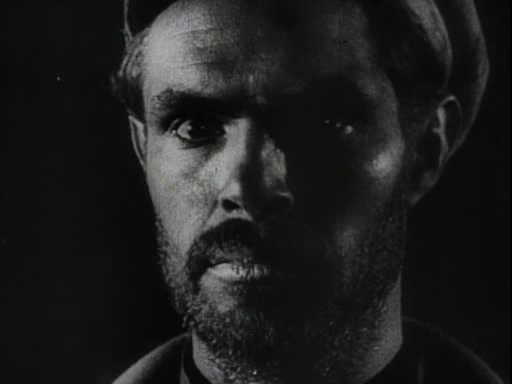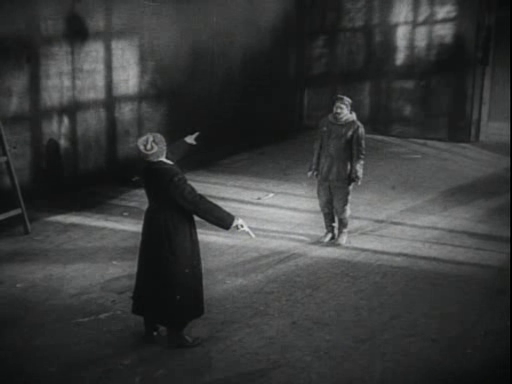No doubt if I’d completed that essay I might understand
Alexander Dovzhenko’s Arsenal a
little better but I suspect that this is a film designed to hedge its bets, to
avoid being pinned down at a time when being off message could be a dangerous
thing.
Arsenal is
anti-war and pro-revolution but it is not simply pro-Soviet even when it
climaxes with the uprising in Ukraine by workers sympathetic to the Bolshevik
cause. Some of these men were as passionately Ukrainian as communist. The
film’s main character, Tymish (Semen Svashenko) refers to himself as a “Ukrainian
worker” and the emphasis is equally on both. He is supernaturally empowered by
this dual classification and acts as an emblem of righteous struggle. His
specific oppressors in the film are the Ukrainian government, the short-lived
Central Rada, but he may also be sending a message to a later regime that the
struggle – for the Workers and for Ukraine - will continue no matter who and what the odds.
 |
| Semen Svashenko |
Arsenal’s style
is all its own with impressionistic rhythms initially appearing disjointed but
viewed on its own terms it rewards your attention. The second part of
Dovzhenko’s Ukrainian Trilogy, after Zvenigora
(1928) and before Earth (1930), Arsenal deals with the period between
the start of the 1917 revolutions through to the January Kiev Arsenal uprising
which, whilst unsuccessful, distracted the reactionary forces enough to allow
the Bolshevik army to gain more ground, thereby helping them to enter the
capital early in the following month. Not that that was the end of things…
The senseless bloody confusion of the period informs
events from the very start as the swirling narrative begins… There was a woman who had three sons…
and we see soldiers travelling on a train, their heads almost in silhouette
against the fast-moving ground below as they try and make themselves
comfortable.
  |
| A mother... some sons |
The sons were all
lost in the War along with so many others. We see mutilated survivors and are
shown a village populated by cripples and women standing in desolation or
offering themselves to shockingly disinterested punters in the form of a local
policeman. Authority is corrupt and society is destroyed by the shame of
absence.
A widow is shown fighting to plough the earth eventually dropping
with exhaustion, then a one-armed man fights with his horse as another widow
beats her children at the end of her tether – “You’re beating the wrong one Ivan” the horse appears to say…
They’re not the ones to blame.
 |
| City of women |
Arsenal treats
its viewers with respect and you have to remember that everyone would have been
all too familiar with the events of 1917-18 and if we’re not now, we really should
remind ourselves…
Dovzhenko dovetailed his film with this audience
experience and recreated the desolate Great War with absurdist economy.
Familiar shots of muddy battle fields end up with men attacking empty trenches,
whilst the soldiers are difficult to identify as from one side or the other
(they are all workers though). Then there is the famous sequence as a German
soldier (Ambrose Buchma) starts to feel the horrific effects of laughing gas; laughing his head off feet away from a fallen
comrade, lying dead with his face contorted in a manic grin. Buchma was
well-known to the watching workers and seeing him laughing in the insanity of
certain death would have hit hard.
+Laughing-Gassed+German+Soldier.png) |
| Ambrose Buchma |
Dovzhenko was criticised at the time for not detailing
more of the motivations behind the uprising and the conflict between the Ukrainian
authorities and the revolutionaries. Maybe he thought such direct meaning was
unnecessary or at least unnecessarily dangerous?
Tymish’s story runs through the whole film from the
failing moments of the Tsar's War up to his role in the Arsenal Uprising - his
presence is more symbolic than strictly “documentary”: a single revolutionary
soldier to embody the struggle of millions.
Tymish is revealed to be the leader of the men on the
train as they leave the front and head home. They are confronted by a group of
soldiers who look set to stop them by force but, at Tymish’s signal the
tarpaulin is pulled aside to reveal rows of machines guns packed on the trucks.
They force their way through but they do not have a driver and the train only
succeeds in crashing: not the outcome one expects: revolution off the rails.
There’s something wrong.
Spoilers…kind of…
Tymish makes it back to Kiev and decides to join the Bolsheviks in struggle
after seeing the reluctance of the Rada to complete the revolution: he wants
the Ukrainian nation to have “Soviet power”.
The men seize control of the arsenal and a bitter battle
is staged. There are betrayals and an horrific moment when two men confront
each other. One has a loaded gun he has not the courage to fire and the other,
turning away from the wall he was to be executed against, slowly walks towards
him, takes the weapon and shoots him dead. This is war: some men are capable
killers whilst others cannot kill even to save themselves. Maybe it’s the
courage of conviction?
Through it all Semen Svashenko’s Tymish draws the eye
with a firm resolution and an unquestionable integrity. In the end his truth is
the film’s own and he cannot simply be blown away.
Danylo Demutsky’s cinematography is also outstanding.
Demutsky had been an avant-garde photographer and his image-making has the
off-kilter power to match Dovzhenko’s subtlety: there are so many memorable
images. The director’s oft-quoted background as a cartoonist may also have
influenced his episodic style: a series of outstanding set-pieces that hit home
harder than some more character-based narratives.
  |
| Angles and atmosphere |
Arsenal not
only stands the test of time it pulls you back and I’ve found myself digging
out old textbooks to find out more about the end of Russia’s war and the
start of its revolution. Now, as Ukraine is on the verge of being undermined
and at least partially absorbed back into Russia, you can only think that not
only was my tutor correct but that Dovzhenko
would not have been in the least surprised.
It’s available from Mr Bongo…either on single DVD or in a
set with Zvenigora and Earth – exceptional value from Movie
Mail or Amazon.
Dr Robert Gildea is a prolific writer on nineteenth and twentieth century history and I can especially recommend Barricades and Borders: Europe 1800-1914 as a good starting point.
















+2.jpg)

No comments:
Post a Comment